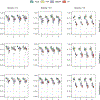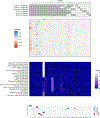Bayesian combinatorial MultiStudy factor analysis
- PMID: 37786772
- PMCID: PMC10543692
- DOI: 10.1214/22-aoas1715
Bayesian combinatorial MultiStudy factor analysis
Abstract
Mutations in the BRCA1 and BRCA2 genes are known to be highly associated with breast cancer. Identifying both shared and unique transcript expression patterns in blood samples from these groups can shed insight into if and how the disease mechanisms differ among individuals by mutation status, but this is challenging in the high-dimensional setting. A recent method, Bayesian Multi-Study Factor Analysis (BMSFA), identifies latent factors common to all studies (or equivalently, groups) and latent factors specific to individual studies. However, BMSFA does not allow for factors shared by more than one but less than all studies. This is critical in our context, as we may expect some but not all signals to be shared by BRCA1-and BRCA2-mutation carriers but not necessarily other high-risk groups. We extend BMSFA by introducing a new method, Tetris, for Bayesian combinatorial multi-study factor analysis, which identifies latent factors that any combination of studies or groups can share. We model the subsets of studies that share latent factors with an Indian Buffet Process, and offer a way to summarize uncertainty in the sharing patterns using credible balls. We test our method with an extensive range of simulations, and showcase its utility not only in dimension reduction but also in covariance estimation. When applied to transcript expression data from high-risk families grouped by mutation status, Tetris reveals the features and pathways characterizing each group and the sharing patterns among them. Finally, we further extend Tetris to discover groupings of samples when group labels are not provided, which can elucidate additional structure in these data.
Keywords: Dimension Reduction; Factor Analysis; Gibbs Sampling; Multi-study Analysis; Unsupervised Learning.
Figures







References
-
- Abdi H (2007). RV coefficient and congruence coefficient. Encyclopedia of measurement and statistics 849–853.
-
- Berger JO and Pericchi LR (1996). The intrinsic Bayes factor for model selection and prediction. Journal of the American Statistical Association 91 109–122.
-
- Chen J and Chen Z (2008). Extended Bayesian information criteria for model selection with large model spaces. Biometrika 95 759–771.
-
- Chipman H, George EI, McCulloch RE, Clyde M, Foster DP and Stine RA (2001). The practical implementation of Bayesian model selection. Lecture Notes-Monograph Series 65–134.
Grants and funding
LinkOut - more resources
Full Text Sources
Miscellaneous
